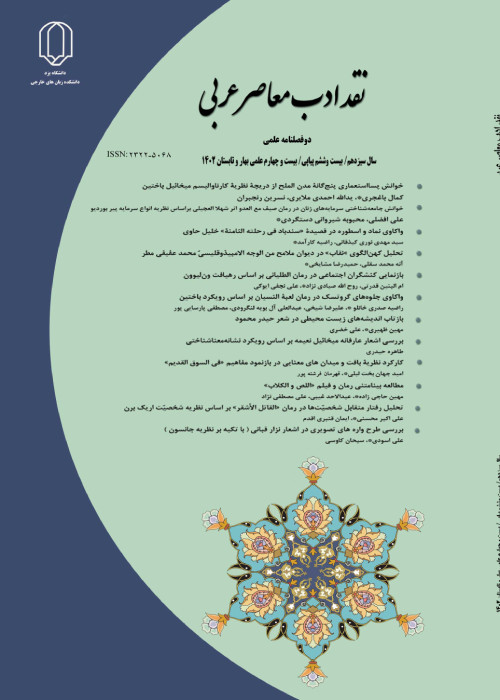The function of an implied reader in cultivating the imagination of a child in Sobhi Suleiman's children’s stories
Author(s):
Article Type:
Research/Original Article (دارای رتبه معتبر)
Abstract:
Introduction
The aim of this study is to evaluate the effects of the reader’s presence and participation in the stories of Sobhi Suleiman. With the initial reading of the desired stories, it is assumed that the author has been influenced by the child's specific intellectual and linguistic framework in the creation of each of these stories.In modern literary criticism, the reader plays such an important role in reading and receiving the meaning of the text that many theorists in this field consider the reader as the main purpose of creating the text. This requires that the constituent elements of the text (author, reader, and message) have a proper and logical relationship with one another. In contemporary literary texts, it is the reader who chooses the text, and his choice affects the different stages of a literary relationship. If the author selects his audience while creating a work of art, he places the text in a circle of rules and special tastes of the reader. Deviating from any of them causes a noticeable decrease in the reading of that text by the reader. This approach in literary criticism is known as the mental presence of the reader in the text. In contrast, there is another approach believing in the indifference of literary texts to the reader's tastes and moods. They state that it is the writer who plays a pivotal and fundamental role in the emergence of a literary text. If the reader of such texts is a child, due to the complexity of the content and its wide vocabulary, the texts will fail to attract the child’s attention and to be welcomed.Methodology
The present research seeks to analyze the children's stories written by Sobhi Suleiman, a contemporary Egyptian novelist, based on the descriptive-analytical method and the theory of the text reception and its adaptation to the child's literary texts. So far, several illustrated story collections have been published by this author. In this research, some of his short stories were randomly selected. These stories are generally written for age groups "B" and "C". The term "latent reader" was first coined by Aiden Chambers. To reach the latent reader, elements such as style, perspective, advocacy, and rational gaps must be explored. The style is the manner of using the language to convey meaning and to connect the author's secondary self and the reader within the text. It includes the choice of words, sentence structure, and the author's attitude toward beliefs and customs. The perspective is to place the reader (child) at the center of the story and to tell the story through his or her presence. The element of advocacy means understanding the child's world, aligning with it, and creating the conditions for the child to participate in the story as a reader. Thus, the author expects the child to both accompany the story and distance himself from it so that he can understand the story deeply. The rational gaps in this regard include infrastructure (content) and superstructure (form) gaps.Results and Discussion
In contemporary criticism, the author's dominance over the text gradually diminishes and the reader finds the main role. Therefore, in such a critique, a special look is taken at the position of the text and its interpretive power and the position of the audience and the way of receiving it. In children's literature, critics of reader-centered texts emphasize that the more attention the writer pays to the child and emphasizes the conditions of his presence as a complementary element of the text, the better the text is. They pursue the originality of children's literature neither in the eyes of the child's writer nor in the text, but in its ultimate goal, the reader (child). The results show that the above stories are closely related to the child's world. This is because, throughout the stories, the author uses techniques such as spelling, spacing characterization, dual structures, rotational rotation, prior awareness, and context with the aim of encouraging the child to read or listen to the rest of the story and making him or her an agent.Conclusion
Before writing the stories, Sobhi Suleiman had a general idea of the child's mental world, and this foreknowledge has given the texts of the stories a relational structure. To achieve this goal, he has left some spaces in the text blank or removed parts of the text by some dots. In order to receive the desired meaning, the child emphasizes his presence in the text and enjoys this mutual interaction through filling the blanks and suggesting different solutions for the characters of the story. In these stories, there are two ways of creating gaps in the common characterization; a character with a special physical dimension is introduced with different physical characteristics, or the phenomenon that plays a major role in the story is introduced significantly different from the adult world in terms of internal and emotional dimension.Keywords:
Language:
Persian
Published:
نشریه نقد ادب معاصر عربی, Volume:12 Issue: 23, 2023
Pages:
67 to 90
magiran.com/p2561471
دانلود و مطالعه متن این مقاله با یکی از روشهای زیر امکان پذیر است:
اشتراک شخصی
با عضویت و پرداخت آنلاین حق اشتراک یکساله به مبلغ 1,390,000ريال میتوانید 70 عنوان مطلب دانلود کنید!
اشتراک سازمانی
به کتابخانه دانشگاه یا محل کار خود پیشنهاد کنید تا اشتراک سازمانی این پایگاه را برای دسترسی نامحدود همه کاربران به متن مطالب تهیه نمایند!
توجه!
- حق عضویت دریافتی صرف حمایت از نشریات عضو و نگهداری، تکمیل و توسعه مگیران میشود.
- پرداخت حق اشتراک و دانلود مقالات اجازه بازنشر آن در سایر رسانههای چاپی و دیجیتال را به کاربر نمیدهد.
In order to view content subscription is required
Personal subscription
Subscribe magiran.com for 70 € euros via PayPal and download 70 articles during a year.
Organization subscription
Please contact us to subscribe your university or library for unlimited access!



